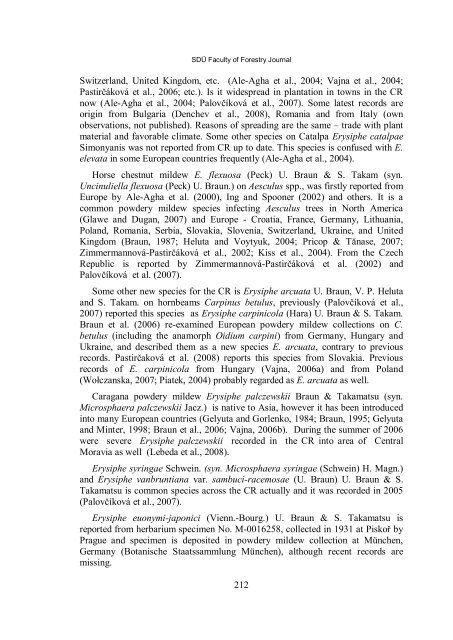sdu faculty of forestry journal special edition 2009 - Orman Fakültesi
sdu faculty of forestry journal special edition 2009 - Orman Fakültesi
sdu faculty of forestry journal special edition 2009 - Orman Fakültesi
You also want an ePaper? Increase the reach of your titles
YUMPU automatically turns print PDFs into web optimized ePapers that Google loves.
SDÜ Faculty <strong>of</strong> Forestry Journal<br />
Switzerland, United Kingdom, etc. (Ale-Agha et al., 2004; Vajna et al., 2004;<br />
Pastirčáková et al., 2006; etc.). Is it widespread in plantation in towns in the CR<br />
now (Ale-Agha et al., 2004; Palovčíková et al., 2007). Some latest records are<br />
origin from Bulgaria (Denchev et al., 2008), Romania and from Italy (own<br />
observations, not published). Reasons <strong>of</strong> spreading are the same – trade with plant<br />
material and favorable climate. Some other species on Catalpa Erysiphe catalpae<br />
Simonyanis was not reported from CR up to date. This species is confused with E.<br />
elevata in some European countries frequently (Ale-Agha et al., 2004).<br />
Horse chestnut mildew E. flexuosa (Peck) U. Braun & S. Takam (syn.<br />
Uncinuliella flexuosa (Peck) U. Braun.) on Aesculus spp., was firstly reported from<br />
Europe by Ale-Agha et al. (2000), Ing and Spooner (2002) and others. It is a<br />
common powdery mildew species infecting Aesculus trees in North America<br />
(Glawe and Dugan, 2007) and Europe - Croatia, France, Germany, Lithuania,<br />
Poland, Romania, Serbia, Slovakia, Slovenia, Switzerland, Ukraine, and United<br />
Kingdom (Braun, 1987; Heluta and Voytyuk, 2004; Pricop & Tănase, 2007;<br />
Zimmermannová-Pastirčáková et al., 2002; Kiss et al., 2004). From the Czech<br />
Republic is reported by Zimmermannová-Pastirčáková et al. (2002) and<br />
Palovčíková et al. (2007).<br />
Some other new species for the CR is Erysiphe arcuata U. Braun, V. P. Heluta<br />
and S. Takam. on hornbeams Carpinus betulus, previously (Palovčíková et al.,<br />
2007) reported this species as Erysiphe carpinicola (Hara) U. Braun & S. Takam.<br />
Braun et al. (2006) re-examined European powdery mildew collections on C.<br />
betulus (including the anamorph Oidium carpini) from Germany, Hungary and<br />
Ukraine, and described them as a new species E. arcuata, contrary to previous<br />
records. Pastirčaková et al. (2008) reports this species from Slovakia. Previous<br />
records <strong>of</strong> E. carpinicola from Hungary (Vajna, 2006a) and from Poland<br />
(Wołczanska, 2007; Piatek, 2004) probably regarded as E. arcuata as well.<br />
Caragana powdery mildew Erysiphe palczewskii Braun & Takamatsu (syn.<br />
Microsphaera palczewskii Jacz.) is native to Asia, however it has been introduced<br />
into many European countries (Gelyuta and Gorlenko, 1984; Braun, 1995; Gelyuta<br />
and Minter, 1998; Braun et al., 2006; Vajna, 2006b). During the summer <strong>of</strong> 2006<br />
were severe Erysiphe palczewskii recorded in the CR into area <strong>of</strong> Central<br />
Moravia as well (Lebeda et al., 2008).<br />
Erysiphe syringae Schwein. (syn. Microsphaera syringae (Schwein) H. Magn.)<br />
and Erysiphe vanbruntiana var. sambuci-racemosae (U. Braun) U. Braun & S.<br />
Takamatsu is common species across the CR actually and it was recorded in 2005<br />
(Palovčíková et al., 2007).<br />
Erysiphe euonymi-japonici (Vienn.-Bourg.) U. Braun & S. Takamatsu is<br />
reported from herbarium specimen No. M-0016258, collected in 1931 at Piskoř by<br />
Prague and specimen is deposited in powdery mildew collection at München,<br />
Germany (Botanische Staatssammlung München), although recent records are<br />
missing.<br />
212








